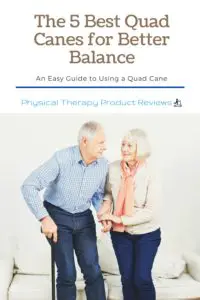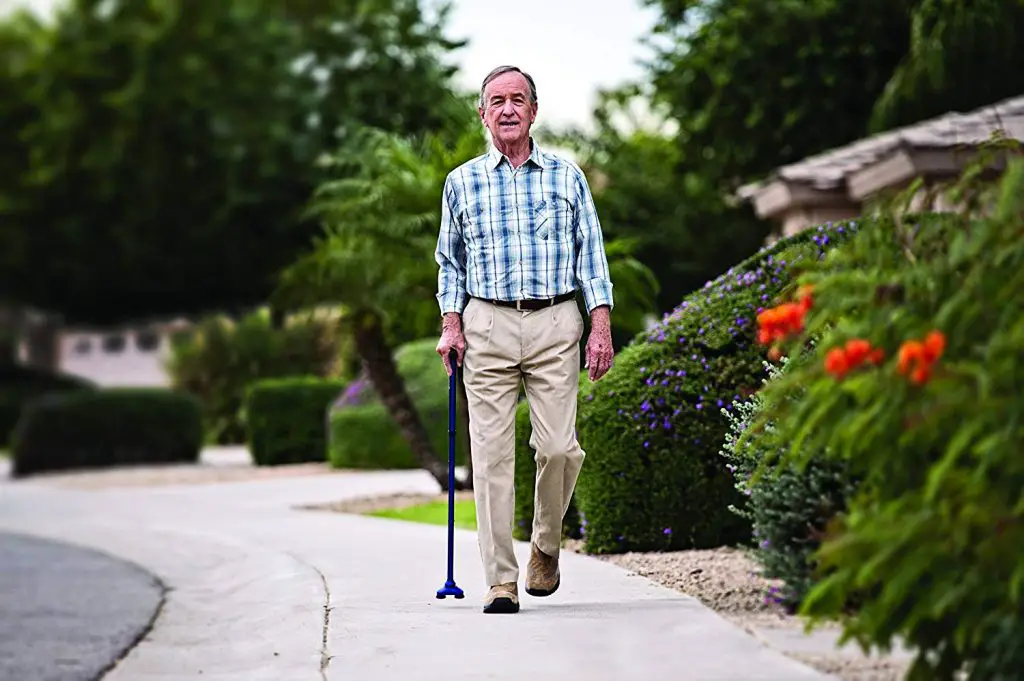One of the most common medical devices used in the United states is a cane. As our balance begins to decrease, we have to decide if we need to move from a single point cane to a quad cane or to a walker. Insurance only covers so many medical devices within a 5 year span so it makes sense to look for inexpensive options. A quad cane can provide additional support without losing independent mobility.
| Name | Picture | Price | Best Feature | Our rating | Best Price |
|---|---|---|---|---|---|
| HurryCane Quad Cane |
 |
$ | Folds up and stays standing on its own | 9.7/10 | See Current Price |
| Hugo Mobility Quadpod Quad Cane |
 |
$ | 54% lighter and 80% more compact than a large base quad cane | 9.5/10 | See Current Price |
| Vive Quad Cane |
 |
$ | Lightweight but yet extremely sturdy cane | 9.5/10 | See Current Price |
| Hugo Adjustable Quad Cane |
 |
$ | Best for bariatric and heavy individuals | 9.4/10 | See Current Price |
| Duro-Med Adjustable Quad Cane |
 |
$ | Great can for stroke patients | 9.2/10 | See Current Price |
What is a Quad Cane?
Quad canes are exceptionally helpful for individuals with difficulty walking or posturing. Due to the nature of their design, they help to effectively balance you whether you’re in motion or standing still. Seniors will find themselves getting used to walking with these canes easier than with a traditional, singular cane, as they provide more all-over support. When old age and health disorders prevent efficient movement, quad canes offer the best overall support and rehabilitation.
Who would Benefit from using a Quad Cane?
The goal of a quad cane is to provide symmetry and balance to walking that the person can no longer achieve themselves. Quad canes are best for:
- Individuals with balance and equilibrium problems
- Seniors and those who have suffer from a neurological disease
- Stroke survivors would benefit the most from quad canes.
- Anyone with a long term illness that required them to be in bed for a long period of time would also need a quad can to help them retain their mobility.
As people age their balance tends to get worse which can result in serious falls. Preventing falls before they happen is key to safety.
Quad Cane vs Single Point Cane
Single point canes can offer a more “stylish” approach to using a cane that is typically recommended for seniors, but they don’t have the same level of practicality that quad canes offer. When you use a quad cane, you’re giving yourself a greater sense of balance and security, since there are at least four points connected to the ground at any time. You won’t need to worry about slips and falls with pretty much any quad cane you can purchase.
Quads canes offer:
- More support for balance
- Ability to bear more weight in cane
- More tolerance to pressure through the cane
Single point canes are more sleek and slender and are better suited for people that need a little bit of balance support. In a study in gait mechanics, work load was determined to be considerable less when people used a single point cane as compared to a quad cane. Where as quad canes are better for people who needs moderate or poor balance.
Single cane offers:
- Quicker walking while still providing support
- Lighter cane and easier movement
- More mobility in tight areas and around the community
Tip: If you are having a hard time deciding which cane to use, go with the more supportive cane first for safety and try to improve strength and balance to progress to a single point or no cane at all.
Features to Look for in a Quality Quad Cane
 Adjustable Height: Allows the user to properly customize a comfortable positioning of their cane regardless of their height. In this way, you can get the best and most efficient usage of it without straining your back or legs.
Adjustable Height: Allows the user to properly customize a comfortable positioning of their cane regardless of their height. In this way, you can get the best and most efficient usage of it without straining your back or legs.
Reversible Base: Reversible bases and grips allow for ambidextrous usage of the cane, so you can even lend it to your friends to try out! This customization also allows more people to take advantage of the ergonomic aspects of the cane that work towards easy physical healing.
Handle type and comfort: Most quad cane handles are comprised of quality, flexible rubber that offer unique grip types for all individuals. Whether you are light or heavy on your feet, you can expect a great deal of comfort in knowing you are safe and balanced with a quad cane.
Weight of the Cane: Cane weight can be a deciding factor in whether or not seniors and debilitated individuals decide to use a quad cane. Some models may be heavier than others but are far more practical in helping with pain and mobility issues
Price vs Performance: Anyone in the market for a quad cane should be willing to invest more in something that will help them versus not. When you are looking for a product that will help you, sometimes it literally pays to have something cost a bit more in order to ensure that it works. Build quality and usability are the two biggest factors in whether or not a cane will help with your condition.
Many quad canes are available to purchase for a wide variety of mobility issues and more. Choosing the right one comes down to how much you are willing to spend as well as how bad your mobility is. Depending on your condition, one cane may prove to be better than another for you.
FAQ About Quad Canes
Why are they Called Quad Canes?
They are called quad canes because of the number of prongs or places that come in contact with the ground. The more points of contact with the ground the more stable. Canes with only one point of contact are called single point canes.
How do you Use a Quad Cane on Stairs?
Stairs and quad canes can be tricky depending on if there is a railing or not. To go up stairs use one hand on a railing, while lifting the cane up to the step above you. Use your arms on the railing and cane to help pull you up to the next step.
To go down the stairs lead with the cane to help with support. While holding on to the railing, place the cane on the stair below you and lower your weakest leg down first. This will allow your stronger leg to control your descent down the step.
Which side do you use a Cane on?
If possible, you want to use the cane on the opposite side of the injury. This is for two main reasons.
- It helps with normal gait pattern to keep us symmetrical when we extend opposite arm and leg.
- The further away from the weaker side the cane is the more support it actually provides. If you remember back to physics and length of the moment arm.
Does Insurance pay for a Quad Cane?
Medicare can pay for a cane but we issue a word of caution. Medicare, especially in recent years, has gotten tricky on what they will cover. Often times they will only cover one assistive device every 5 years. If you think that you will need more than walking aid in that time period plan ahead to use cash on the less expensive items and save the expensive ones for insurance.
Do you have poor balance and a fear of falling in the shower? Check out the best shower chairs for seniors to help keep you upright in the shower.
How to Walk with a Quad Cane
The Best Quad Canes for the Elderly
HurryCane Freedom Edition
Summary: The HurryCane small quad based cane is reported to be the #1 selling cane in America. It has innovative SteadiGrip stabilizing technology which increases traction and improves balance which is what you are after. It also comes with an adjustable height handle for different heights of people.
Pros: Best for individuals in need of just a little balance help. It’s lightweight and easy to use.
Cons: Not meant to support heavy loads or provide large amounts of balance aid. Best for those in need of a little bit of balance help
Hugo Mobility Quadpod Offset Cane
Summary: The Hugo Mobility Quad Pod Cane is sleek and slender which allows for added balance support without the extra weight of the larger canes. This is easily one of the most popular canes on the internet and for good reason.
Pros: 54% lighter than normal quad base models with a comfortable easy to use handle.
Cons: Has a 300 lb weight limit and the bottom of the cane may wear out faster than other models.
Vive Quad Cane
Summary: The Vive Quad Cane offers incredible stability with four points of contact, as well as superior traction in and out of doors with a secure and corrosion-resistant grip. Sleek and lightweight for a quad point cane.
Pros: Ergonomically situated grip and thrifty price range allow for a secure and foolproof quad cane for new users.
Cons: Rubber tips not always in conjunction with one another in regards to points of contact.
Hugo Adjustable Quad Cane
Summary: The Hugo Adjustable Quad Cane can handle a large weight load capacity of 500-lbs as well as an adjustable left or right hand grip for users of all hand dominance.
Pros: Stands firmly upon almost any surface and allows for a steady flexibility in everyday use.
Cons: Has a less than ideal lowest height range at twenty-nine inches.
Duro-Med Adjustable Large Base Quad Cane
Summary: The Duro-Med Adjustable Large Base Quad Cane has four points of floor contact along with rubber/latex blend of feet composition. Offers slip resistance and eye-pleasing coloring for everyday use.
Pros: Ample support for one side with individuals that have mobility issues. A large base precludes efficient movement capability.
Cons: Handle pad could be slightly thicker to allow for a better grip on the cane itself.
Conclusion:
Many quad canes exist for a wide range of mobility problems. No matter what the reason may be, you can be assured that there is a product out there for you that will provide relief and comfort in retaining your mobility independence.
Other Great Rehab Related Articles
GLP Weight Loss and Back Health: Effective Strategies and Insights
How to Stay Active After Cervical Fractures: Expert Tips and Advice
Dealing with Painful Stairs After Ankle Replacement Surgery
Walking After a Total Ankle Replacement: Tips for a Successful Recovery
Exercises While Non-Weight Bearing After Ankle Replacement: Elevation, AROM, Leg Raises, and More
Ankle Pain with Stairs: Causes and Home Treatment Options
Disclaimer: The information provided in this post is for educational purposes only. This is not a substitute for a medical appointment. Please refer to your physician before starting any exercise program.












